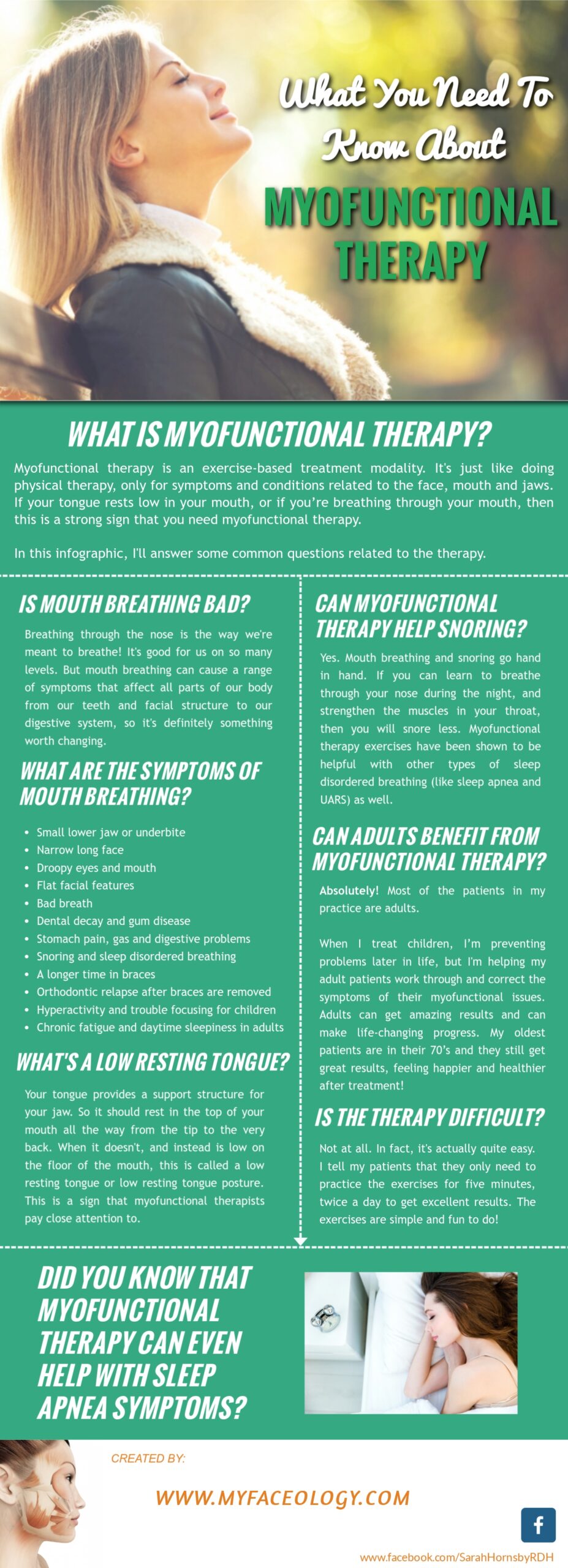This is the third of my infographics about myofunctional therapy. The first one was about my Four Goals of Myofunctional Therapy, and the second was all about tongue-ties. In this one, I’ve answered some of the most common questions that I get asked by potential patients and other people interested in learning more about what I do as a myofunctional therapist.
I hope you enjoy it!
Please feel free to share it – the full resolution JPG is below, and here’s a link to a PDF version as well.

What Is Myofunctional Therapy?
Myofunctional therapy is an exercise-based treatment modality. It’s just like doing physical therapy, only for symptoms and conditions related to the face, mouth and jaws. If your tongue rests low in your mouth, or if you’re breathing through your mouth, then this is a strong sign that you need myofunctional therapy.
Is Mouth Breathing Bad?
Breathing through the nose is the way we’re meant to breathe! It’s good for us on so many levels. But mouth breathing can cause a range of symptoms that affect all parts of our body from our teeth and facial structure to our digestive system, so it’s definitely something worth changing.
What Are The Symptoms Of Mouth Breathing?
- Small lower jaw or underbite
- Narrow long face
- Droopy eyes and mouth
- Flat facial features
- Bad breath
- Dental decay and gum disease
- Stomach pain, gas and digestive problems
- Snoring and sleep disordered breathing
- A longer time in braces
- Orthodontic relapse after braces are removed
- Hyperactivity and trouble focusing for children
- Chronic fatigue and daytime sleepiness in adults
What’s A Low Resting Tongue?
Your tongue provides a support structure for your jaw. So it should rest in the top of your mouth all the way from the tip to the very back. When it doesn’t, and instead is low on the floor of the mouth, this is called a low resting tongue or low resting tongue posture. This is a sign that myofunctional therapists pay close attention to.
Can Myofunctional Therapy Help Snoring?
Yes. Mouth breathing and snoring go hand in hand. If you can learn to breathe through your nose during the night, and strengthen the muscles in your throat, then you will snore less. Myofunctional therapy exercises have been shown to be helpful with other types of sleep disordered breathing (like sleep apnea and UARS) as well.
Can Adults Benefit From Myofunctional Therapy?
Absolutely! Most of the patients in my practice are adults.
When I treat children, I’m preventing problems later in life, but I’m helping my adult patients work through and correct the symptoms of their myofunctional issues. Adults can get amazing results and can make life-changing progress. My oldest patients are in their 70’s and they still get great results, feeling happier and healthier after treatment!
Is The Therapy Difficult?
Not at all. In fact, it’s actually quite easy. I tell my patients that they only need to practice the exercises for five minutes, twice a day to get excellent results. The exercises are simple and fun to do!




